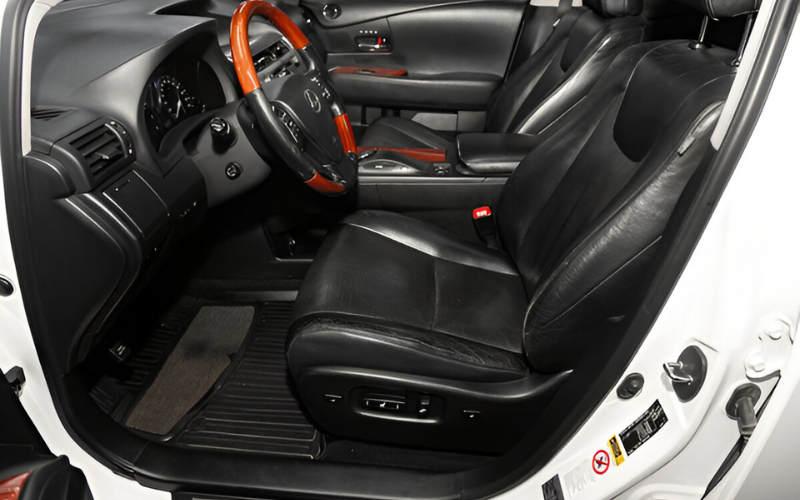If you’re considering a Lexus ES350 from 2010, there’s a good chance you’ve heard about its smooth ride, reliable engine, and upscale feel. But one feature that often gets overlooked—until you’re behind the wheel—is the driver seat. Whether you’re buying this vehicle used, trying to fix a seat issue, or just curious about comfort over time, this guide will walk you through everything you need to know about the driver seat Lexus ES350 2010. We’ll talk materials, functions, known problems, and what to expect long-term.
Features of the 2010 Lexus ES350 Driver Seat
The 2010 ES350 was designed with comfort in mind, and nowhere is that more noticeable than in the driver seat. From standard features to available upgrades, the seat blends luxury and practicality.
Depending on the trim level, the driver seat came with either standard perforated leather or upgraded semi-aniline leather. Most 2010 ES350 models include 10-way power adjustments, making it easy to find a comfortable position regardless of your height or posture. These adjustments include options for seat height, tilt, backrest angle, and forward/back movement.
Another key feature is lumbar support, which can be adjusted electronically for lower back comfort during long drives. Many models also offer memory settings for two drivers, allowing you to store your seat position for quick access. In higher trims, you might also find heated and ventilated seat options, which are especially useful in extreme climates.
All of these features make the driver seat in the Lexus ES350 2010 not only comfortable but also functional for daily driving and long-distance travel.
Common Problems with the Driver Seat Lexus ES350 2010
Even with luxury and comfort built in, the driver seat on the 2010 ES350 isn’t perfect. Like any part of a 10+ year-old car, time takes a toll. Here are a few issues that owners commonly report.
Power motor failure and stuck positions
One of the most talked-about concerns is the power seat motor failing. You might notice the seat stops moving entirely, or only responds to certain adjustments. In some cases, the seat becomes stuck in one position, which can be a serious issue for drivers who need to change settings often.
This can be due to a worn-out motor, faulty wiring, or even a damaged switch. If the seat won’t move at all, the first step is to check the fuse box to rule out an electrical issue. If that doesn’t solve it, the motor assembly under the seat may need replacement.
Leather wear, rips, and cushion sagging
After over a decade of use, leather wear becomes noticeable, especially on the seat bottom and side bolsters. The leather may crack, fade, or even tear depending on usage and care. If the seat wasn’t regularly conditioned or protected from sunlight, wear shows up faster.
Some drivers also report sagging cushions, making the seat feel flat or unsupportive. This issue isn’t just cosmetic—it can affect your comfort and posture, especially on long drives.
Seat track or frame issues over time
The seat track—which allows the seat to move forward and backward—can become noisy, loose, or misaligned. In some cases, drivers feel the seat shift slightly under braking or cornering. That’s often due to worn bolts or frame parts that need tightening or replacement.
Over time, the metal frame underneath the driver seat may also loosen or squeak. These aren’t critical safety issues at first, but they can be frustrating and get worse without attention.
Fixing or Replacing the Driver Seat in a Lexus ES350 2010
If you’re dealing with any of the above issues, don’t worry—there are several ways to fix or replace the driver seat in a 2010 Lexus ES350, depending on your budget and level of experience.
OEM parts vs aftermarket options
Lexus parts are known for their quality, but OEM driver seat parts can be expensive. That includes seat motors, leather upholstery, and track assemblies. While these parts guarantee compatibility, they come at a premium.
Aftermarket options—including compatible motors, rebuilt seat assemblies, or seat covers—can save you money. However, it’s important to make sure the parts are designed specifically for the 2010 Lexus ES350 to avoid fitment issues.
Repair costs for electronics and upholstery
Fixing a power seat motor can cost anywhere from $200 to $600, depending on labor and part prices. If you’re replacing the entire driver seat, costs can jump to $800 or more if you go the OEM route.
Leather reupholstery can also be pricey. A full seat rewrap by a professional upholsterer might cost around $500, but simple DIY leather repair kits are available for much less if the damage is minor.
Step-by-step DIY tips for small fixes
If you’re handy, you can handle some minor repairs yourself. For example, you can replace a broken seat switch, lubricate a noisy track, or re-stuff the cushion foam. Online tutorials and Lexus owner forums often share walkthroughs for 2010 ES350 driver seat repairs, making it easier even for beginners to follow along.
Used Car Buyers: Inspecting the 2010 ES350 Driver Seat
If you’re in the market for a used Lexus ES350 2010, the driver seat is one of the first areas to inspect during your test drive.
Make sure all power seat adjustments work smoothly. Test the forward/back motion, backrest tilt, and lumbar support. Check the memory settings if available, and inspect the leather for cracks or discoloration.
If the seat feels loose or rocks under braking, it may indicate a loose frame or worn seat track. These issues may not be deal-breakers, but they should be considered in the final price.
Also, don’t forget to check under the seat for exposed wiring or signs of rust—especially if the car was used in a humid or coastal region.
Daily Comfort and Real-World Driving Impressions
Many long-term owners say the 2010 Lexus ES350 driver seat holds up well in terms of comfort, even after a decade. The seat’s shape, cushion design, and lumbar support are praised by drivers who spend a lot of time commuting.
In comparison with newer Lexus models, the 2010 seat may feel slightly dated in design, but not lacking in support. It still delivers a smooth, comfortable ride that matches the brand’s luxury image.
Owners with well-maintained leather report very little wear and say the seat still feels “like new,” which speaks to the long-term build quality Lexus is known for.
Conclusion
The driver seat in the Lexus ES350 2010 is a great example of comfort and thoughtful design. While age and use can lead to wear or mechanical problems, most issues are fixable—and often worth the effort if you love the car. Whether you’re buying, fixing, or just learning more about your Lexus, understanding this key feature helps you get the most from your driving experience.
FAQ
Q1: Why won’t the driver seat move in my 2010 Lexus ES350?
The issue could be a failed seat motor, a bad fuse, or a faulty switch. Start by checking the fuse box. If that doesn’t work, a mechanic may need to test the motor wiring.
Q2: Can I install a used driver seat from another ES350 model year?
In many cases, yes—but make sure the wiring harness and seat frame match. Some features may differ by year, especially for memory settings or airbag sensors.
Q3: How much does a replacement driver seat cost for the Lexus ES350 2010?
OEM replacements can cost $800–$1,200. Used seats may cost around $300–$500 depending on condition, features, and location.
Q4: Are there known service issues with the 2010 ES350 seat motor?
Yes, some owners have reported early failures in the power seat motor, particularly if the seat was frequently adjusted or used roughly. It’s not a recall issue, but it’s something to be aware of.
Disclaimer:
This article is for general informational purposes only. The content is based on publicly available information and reflects the author’s understanding at the time of writing. It is not intended to serve as legal, medical, financial, or professional advice. Readers should consult qualified professionals for guidance tailored to their specific needs or circumstances. While efforts are made to keep the information accurate and up to date, no guarantees are made regarding its completeness or reliability.

